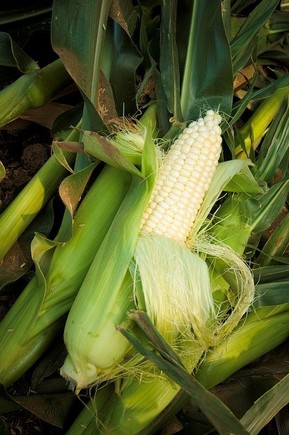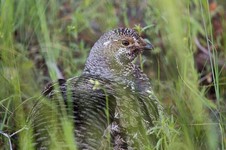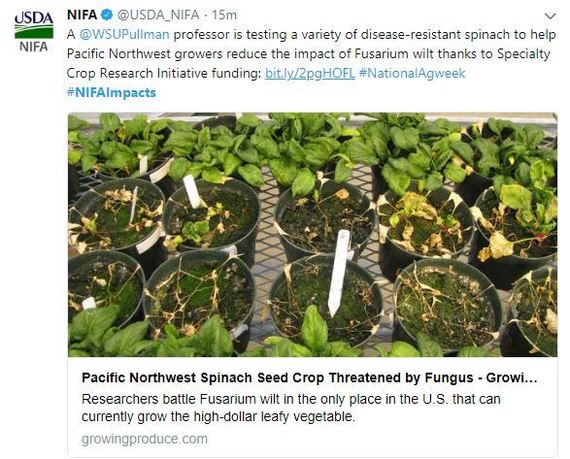|
Having trouble viewing this email? View it as a Web page.

|
|
|
Fresh from the
Field is a weekly album showcasing transformative impacts made by
partners supported by the National Institute of Food and Agriculture.
Editor: Falita Liles
March 22, 2018
|
|
Success Stories

Integrating Two Types of Crop Models to Predict the Effect of Climate
Change on Crop Yields
Researchers from University
of Illinois (UI) are attempting to bridge two types of computational crop
models to become more reliable predictors of crop production in the U.S. Corn
Belt.
“One class of crop models
is agronomy-based and the other is embedded in climate models or earth system
models. They are developed for different purposes and applied at different
scales. Because each has its own strengths and weaknesses, our simple idea is
to combine the strengths of both types of models to make a new crop model with
improved prediction performance,” said Kaiyu Guan, the principal investigator
of this research.
Guan and his team
implemented and evaluated a new maize growth model by combining superior
features in both Community Land Model and Agricultural Production Systems Simulator.
NIFA supports this project
through the Agriculture and Food Research Initiative.
Read the full story at College News at UI. USDA Photo.
|
News Coverage

Detecting
Capture-Related Mortality in Radio-Marked Birds Following Release
Researchers at the University
of Maine are researching the fundamental assumption of avian survival
analysis; that the act of capture, handling, and marking birds does not affect
subsequent survival. This assumption is violated if animals experience injury,
physiological stress, or disorientation during capture and handling that
increases their mortality risk following release. Such capture-related effects
must be accounted for during analysis, typically by censoring individuals from
the survival history, to avoid biasing the resulting survival estimates.
They reviewed studies of
radio-marked upland game birds to characterize researcher approaches for
addressing short-term effects of capture on survival, and used data from a
study of Ruffed Grouse to illustrate an empirical approach for evaluating such
effects and identifying time thresholds to censor birds that die shortly after
release. A majority of studies (65 percent) reported using some form of
censoring for mortality that occurred within one to three weeks after release,
although only 8 percent of studies reported an empirical approach to identify a
threshold for censorship. The researchers found that Ruffed Grouse mortality
was greater from one to six days following release when compared with seven to
30 days.
NIFA supports this project
through the McIntire-Stennis Capacity Grant Program.
Read the full article at Avian Conservation and Ecology. Photo by Neal Herbert/National Park Service.
|
The Library
 Illinois
Transdisciplinary Obesity Prevention Program (I-TOPP)
Over the past 30 years,
the prevalence of overweight and obesity has doubled in 2- to 5-year-olds and
tripled in children aged 6 to 11 years. NIFA, in 2011, funded the Illinois
Transdisciplinary Obesity Prevention Program (I-TOPP), a joint doctoral/Masters
of Public Health (MPH) degree program, at the University of Illinois
(UI) with the goal of training future leaders to address the problem of
childhood obesity.
“We know the causes of
childhood obesity are multifactorial, involving both genetic and environmental
causes,” said Sharon Donovan, professor in the Department of Food Science and
Human Nutrition at UI and director of I-TOPP. “Of the environmental factors,
family routines, nutrition, food security, physical activity, sedentary
behavior, and sleep are all important.
The program’s
transdisciplinary approaches span beyond the expertise of instructors and
researchers within academia and also involve community stakeholders. These
approaches, which are often a component of team science, teach students to
master and then integrate broad methods to find solutions to complex public
health problems such as childhood obesity.
NIFA supports this
research through the Agriculture and Food Research Initiative.
Read the full article at College News at UI. Photo credit: Anna Keck/UI.
|
Tweet of the Week
#NIFAIMPACTS

|
|

NIFA’s mission is to invest in and advance agricultural research, education, and extension that solve societal challenges. NIFA’s investments in transformative science directly support the long-term prosperity and global preeminence of U.S. agriculture. To learn more about NIFA’s impact on agricultural sciences, visit www.nifa.usda.gov/Impacts, sign up for email updates or follow us on Twitter @USDA_NIFA, #NIFAImpacts.
USDA is an equal opportunity lender, provider, and employer.
|
|